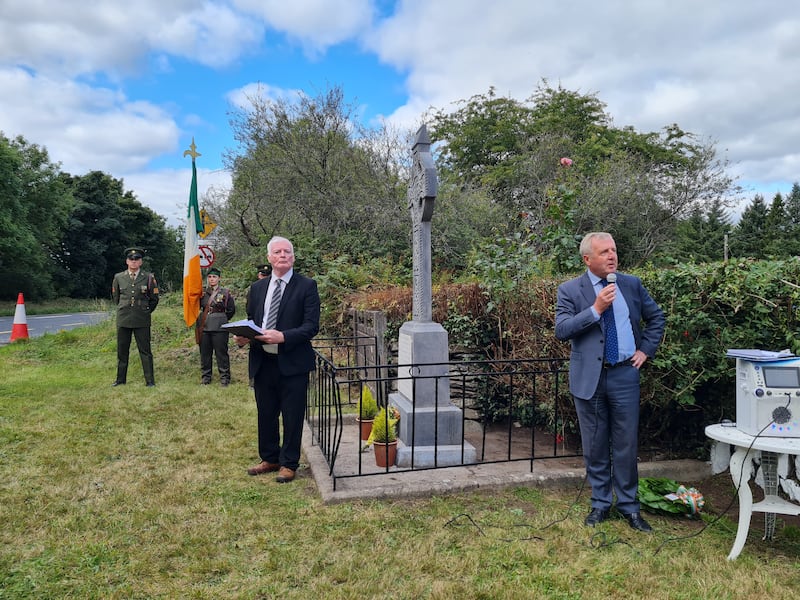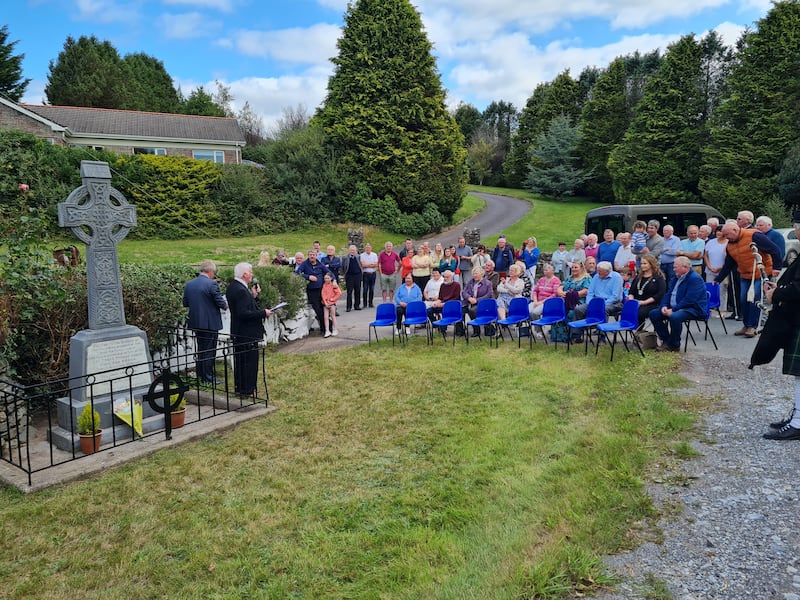Seven National Army soldiers paid the ultimate price in order to lay the foundations of the modern Irish state when they were killed in one of the worst land mine attacks of the Civil War in Co Cork 100 years ago this month, former minister for agriculture Michael Creed has said.
He said the deaths of the seven men while working to clear a landmine laid by the anti-Treaty IRA at Carrigaphooka, 4km west of Macroom, on September 16th, 1922 should not be forgotten by those benefitting from their sacrifice today.
“It is important that we acknowledge the sacrifices made by our forefathers and these seven men in particular, who paid the ultimate sacrifice in laying their lives when laying down the foundation of the modern Irish state and it is a very solid foundation for which we should be eternally grateful,” the Cork North West Fine Gael TD said.
“It’s also important to bear in mind the democratic imprimatur that they had in that work of laying down the foundations of the state that we enjoy today – the 1922 General Election where nearly 80pc of those who voted, voted for pro-Treaty parties.”
Brianna Parkins: The Irish spice bag has arrived in Australia and not everyone is happy
‘We are caring for your parents like they are our parents - but we can’t bring our families here’
What should I do if my electric car breaks down?
Matt Williams: In cynical times, savour the new coaches who want to make the world a bit better
Mr Creed was speaking at a wreath-laying ceremony at a monument on the main Macroom to Ballyvourney Road to the Carrigaphooka dead, organised by a local committee chaired by his cousin and namesake, Cllr Michael Creed from Macroom.
Addressing a crowd of around 80 people, the former minister read out the names of those who died at Carrigaphooka including Col Cmdt Thomas Keogh, Capt Dan O’Brien, Sgt William Murphy, Pt Thomas Manning, Pt John O’Riordan, Pt Patrick O’Rourke and Pt Ralph Conway.
An Evening Echo report at the time painted a horrific picture of the scene that confronted locals when they went to the blast site after hearing an explosion sometime after 7am as the seven troops worked to remove a landmine left near a bridge over the River Foherish.
“Four bodies were terribly disfigured. Two others were in a dying condition... The sole survivor at this point was given all attention possible. He had both legs broken and several contused wounds. He was conveyed to the Mercy Hospital in Cork where he died in the afternoon,” the newspaper reported.
Mr Creed said the highest profile casualty of the explosion was the man who survived the initial blast, Tom Keogh, a native of Knockanna in Co Wicklow, who had joined the Irish Volunteers and fought in Jacob’s Factory during the 1916 Easter Rising before later joining the Dublin Brigade of the IRA.
He said that Keogh became an invaluable member of Michael Collins’ squad during the War of Independence and was involved in the attacks on the Cairo Gang on the morning of Bloody Sunday and later had a lucky escape at Croke Park when crown forces opened fire on the crowd.

Mr Creed said that after Keogh initially survived the blast at Carrigaphooka, he was rushed to the Mercy Hospital where he was nursed by among others, Mary Collins-Powell, older sister of Michael Collins, who had been killed less than a month earlier in an anti-Treaty IRA ambush at Beal na Blath.
He read a letter that Ms Collins Powell wrote to Keogh’s mother after his death in the Mercy on the afternoon of September 16th, 1922, including with it a lock of his hair and a fragment of his tunic which the family still keep as mementoes of his death at the age of 23.
“I find it very hard to write to you with so much sorrow and sympathy in my heart. I was present when Tom died. He died like a tired child going to sleep, just closed his eyes and his mouth and all was over. The nuns and a few of his comrades and myself had the privilege of saying a few prayers for his gallant soul,” wrote Ms Collins Powell.
Mr Creed said it was important to acknowledge in this Decade of Centenaries that the Civil War was a difficult period in Irish history, “one which involved the inflicting of considerable grief and suffering and bitterness but hopefully the intervening years had done much to mend and to heal”.
He noted that the seven troops were not the only casualties at Carrigaphooka that day, a young anti-Treaty IRA man from Macroom, James Buckley, was brought to the scene by National Army soldiers and shot dead near the scene of the explosion.

Dr John Borgonovo, of the School of History at University College Cork, said the landmine explosion at Carrigaphooka was the first major land mine killing of the Civil War with one of the highest number of fatalities.
“It was foreshadowing what would happen in Kerry in Knocknagoshel when five Free State soldiers were killed in a landmine explosion in March 1923, but it also foreshadowed what happened with Ballyseedy, in that the Free State forces in Macroom similarly retaliated and shot James Buckley,” he said.
“What happens in Ballyseedy when eight republican prisoners were blown up and shot and later at Countess Bridge near Killarney and Cahersiveen, when another nine were killed, they were a much more severe response, but they follow the same pattern of reprisal killing seen at Carrigaphooka.”
Dr Boronovo, author of the book The Battle for Cork, said the killing of Buckley had consequences, at least locally, in that the officer commanding the Free State troops in Macroom, War of Independence veteran Capt Peadar Conlon from Longford, complained to Maj-General Emmet Dalton about Buckley’s death.
He explained that Conlon, the hero of the Battle of Rochestown just months earlier, told Dalton that his troops would mutiny if their fellow Free State soldiers continued with a policy of reprisal killings of republican prisoners.
Dr Borgonovo notes that one common thread between the reprisal killing at Carrigaphooka and what was to happen in Kerry six months later was the presence of former members of Collins’ Squad, who became noted during the Civil War for their brutal response to anti-Treaty IRA attacks.




